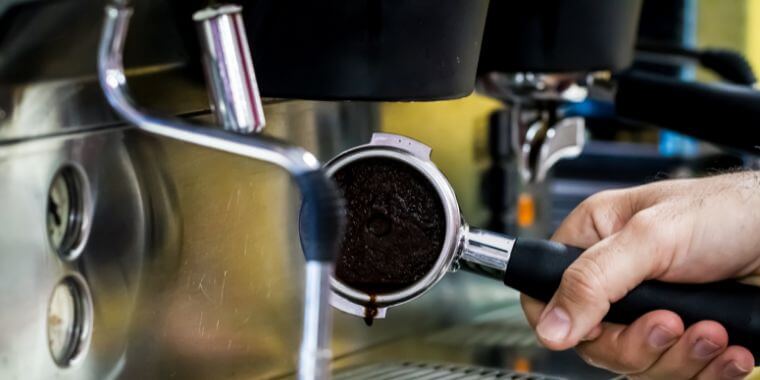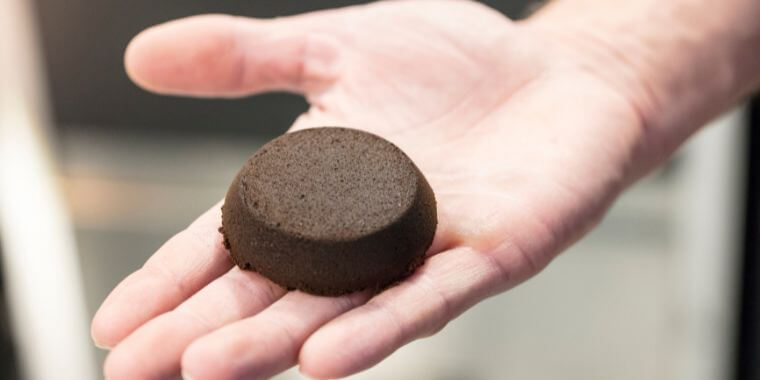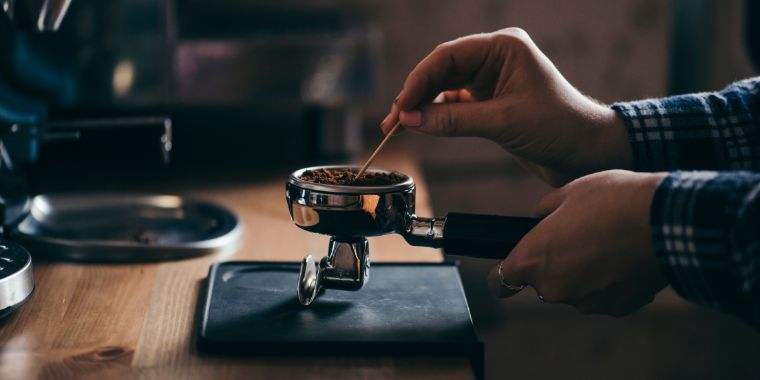If you are tired of pulling a shot of espresso only to find a soggy, soupy mess in your portafilter you are in the right place.
In this article, I’ve gathered essential tips and tricks to help you understand the reasons behind wet espresso grounds and, more importantly, how to fix them.

Why is my Espresso Puck Wet and How to Fix It

As a die-hard espresso fan, I’ve spent countless hours perfecting my espresso game.
One issue that has bugged me over the years is a wet espresso puck.
But don’t worry, I’ve got you covered. Here are some reasons why your espresso puck might be wet and how to fix it.
It’s all about the grind
You see, espresso brewing is super sensitive to grind quality. A coarse or uneven grind can lead to thin, watery coffee and, you guessed it, soggy pucks.
Even when you buy pre-ground coffee labeled for espresso machines, it may still be too coarse.
The best solution? Grinding your own espresso. This ensures optimal grind size and can significantly improve both the puck and brew quality.
So, if you’re serious about your espresso (like me), it’s time to invest in a high-quality espresso grinder.
Now, if your grinds are too coarse or too fine, you’ll end up with wet coffee pucks due to under or over-extraction.
Inconsistently ground beans can also lead to uneven water flow, channeling, and ultimately, wet pucks. Again, a quality espresso grinder can make all the difference.
Another issue that can cause over-extraction and wet pucks is having insufficient grinds in the portafilter. To avoid this, I always weigh my dose before brewing and make sure I distribute it evenly before tamping.
It’s a small step that can have a huge impact on your espresso experience.
So, the bottom line is: invest in a quality espresso grinder, weigh your dose, and nail that grind size.
Wrong size portafilter

Using the wrong size portafilter can cause wet pucks.
If your portafilter is under-filled, it affects the resistance needed for the pressurized hot water system, leading to— you guessed it again —soggy pucks.
To maintain your espresso recipe, always use the right size basket for the number of grounds.
I’ve found that brands like IMS and VST offer quality espresso baskets in various sizes, making it easy to find the perfect fit for your machine.
Not only does the proper basket size improve puck dryness, but it also enhances the taste of your espresso. Believe me, as someone who’s tried different basket sizes, the difference is remarkable.
So, to fix those wet espresso pucks, make sure you’re using the right size portafilter and basket for your grounds.
Tamping Pressure

Loosely-packed grounds can lead to wet pucks, and that’s where proper tamping comes in.
When you tamp correctly, you ensure tightly clumped coffee particles in your basket.
Remember, it’s essential to have the right basket size and grind size for the optimal espresso brew.
A coffee tamper is your best friend when it comes to compressing grounds into a tight cake.
Make sure the tamper diameter fits snugly into the filter basket for the best results. Most baristas prefer a tamping force of 20-30 pounds – I’ve found this range to work well for me too.
Investing in a quality coffee tamper can make all the difference. Give it a shot, and you’ll soon be enjoying a perfectly extracted espresso and dry pucks.
Uneven ground distribution
To avoid soupy pucks, make sure your grounds are distributed evenly in the filter basket. One handy tool I’ve found for creating an even coffee bed is a dosing funnel. Trust me, it’s a game-changer!
The goal is to have consistent density throughout the puck, providing the proper resistance against pressurized water. Low resistance and fast water filtration can lead to uneven extraction, resulting in weak, bitter espresso.
An espresso stirring tool can be a lifesaver for breaking up clumps and spreading grounds evenly. Give the entire basket a good stir, gradually pulling out the needles, to create a smooth, even surface.
By focusing on even ground distribution, you’ll not only prevent wet pucks but also improve the overall quality of your espresso.
Air pockets
Wet coffee pucks can result from a combination of factors, like an improper grind, uneven distribution, clumps, and excess space.
Air pockets in the puck can cause grounds to float, disrupting the espresso process.
Here’s a tip: consider using a puck screen to eliminate air pockets. I’ve found that puck screens help press the puck together, prevent extra water, and promote even water distribution for better extraction.
Water
Now, let’s talk about water. It’s one of the least likely factors to cause wet pucks.
Most espresso machines have preset water temperature and pressure, so as long as you maintain the normal preset units, you should be good to go for optimal espresso results.
Some Questions You May Have
What is an espresso puck?
An espresso puck is the compacted coffee grounds left in the portafilter after brewing a shot of espresso. When tamped properly, it forms a tightly compressed cake that allows hot water to pass through evenly, extracting the coffee’s flavors and oils for that perfect shot of espresso.
Why does espresso need to be in a puck?
Espresso needs to be in a puck to ensure even extraction and optimal flavor. A compact, uniform puck provides the right resistance for hot, pressurized water to pass through, extracting the coffee’s rich flavors and oils.
What should the espresso puck look like
The ideal espresso puck should be flat, solid, and dry. It should have an even surface, with no cracks or channels.
What to do with espresso pucks
After brewing, don’t toss those espresso pucks! You can actually repurpose them. I’ve found they make great additions to compost bins, as they’re rich in nitrogen. You can also use them to absorb odors in your fridge, or even as a natural cleaning scrub for pots and pans.
My final thoughts
Here’s a summary of the main takeaways to help you improve your espresso game:
- Grind size matters: Ensure optimal grind size by investing in a high-quality espresso grinder. Incorrect grind size can lead to under or over-extraction, resulting in wet pucks.
- Choose the right portafilter size: Using the correct size basket for the number of grounds helps maintain your espresso recipe and avoid wet pucks.
- Tamping pressure is crucial: Apply 20-30 lbs of pressure using a quality coffee tamper to create a flat, tight cake before brewing. Insufficient pressure can lead to wet pucks and under-extracted espresso.
- Ensure even ground distribution: Use a dosing funnel and espresso stirring tool to create an even coffee bed in the filter basket, preventing low resistance and fast water filtration that can cause wet pucks.
- Eliminate air pockets: Consider using a puck screen to eliminate air pockets in the puck, promoting even water distribution and better extraction.
- Water: Maintain normal preset water temperature and pressure in your espresso machine for optimal results.
Remember, a well-formed espresso puck is essential for a delicious shot of espresso. By addressing grind size, distribution, tamping pressure, portafilter size, air pockets, and water, you can say goodbye to wet pucks and hello a satisfying espresso experience.

